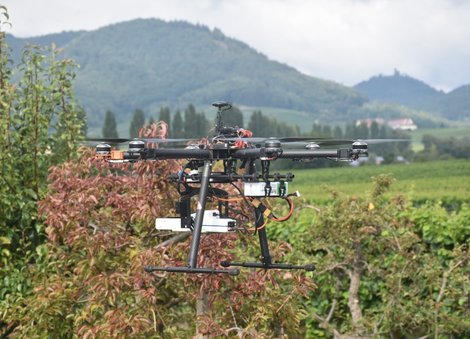Drones and Satellites Detect Diseased Fruit Trees
Scientists at the Fraunhofer IFF are developing digital diagnosis systems for agriculture

Scientists at the Fraunhofer Institute for Factory Operation and Automation IFF in Magdeburg are providing agriculture with expert support as it moves into the digital age. “Faced with a harvest of around 14 million metric tons of apples at risk of disease each year across Europe, we as developers of intelligent, digital systems can come up with solutions,” says Uwe Knauer, a scientist at the IFF. Together with partners, his team is developing an intelligent remote system for detecting fruit diseases.
The demand for locally grown fruit is increasing – and not just because short transport routes are more environmentally friendly. Fruit and vegetables from South Europe or overseas lose many of their vitamins during transportation. Homegrown fruit has a clear advantage on that front. It is picked when it is ripe and contains a full vitamin content – provided it has not suffered from disease. Apple proliferation and pear decline often cause poor harvests for European fruit growers. It is hoped that intelligently networked drones and satellites will soon be able to detect these diseases early on, thus averting substantial economic damage.
Uwe Knauer, expert in machine learning at the Fraunhofer IFF in Magdeburg, shows photos of a tree infected with apple proliferation. As the name of the disease suggests, the tree has a proliferation of high shoots that form what are known as witches’ brooms. The fruit, on the other hand, is small and will not fully ripen. Knauer points to the red coloring of the leaves showing as early as summer, the result of a decline in chlorophyll. The tree is undernourished. Similar symptoms indicate that a tree is suffering from pear decline. Both diseases are caused by phytoplasmas, bacteria without a cell wall that are transmitted by insects and overwinter in root balls. The problem can be tackled effectively by tree clearing, but the parasite infection has to be caught early on, even before the first symptoms show. However, according to Knauer, diagnosis via molecular analysis is very expensive and a visual inspection of every single tree would require a huge number of working hours.
Monitoring land from your desk
It is precisely these problems that AlPlanta Institute for Plant Research in Neustadt an der Weinstraße is investigating. Apple proliferation and pear decline are also spreading in orchards in Rhineland-Palatinate, causing immense economic damage. “AlPlanta came to hear of the IFF because we had developed a smartphone app,” explains Knauer. He goes on to say that the app can carry out spectral measurements to determine skin types or color shades or to assess food, for example. The advancement of this application became the fundamental idea behind a joint research project to provide fruit growers with a reliable as well as time- and cost-saving diagnostic device. The third partner in the alliance is the firm Spatial Business Integration in Darmstadt. SBI is a world-leading provider of satellite-image-based services for sectors including agriculture and forestry. “Agricultural businesses will be able to view their land right down to the smallest detail on the satellite images without leaving their desks,” says Knauer, highlighting this very special potential for the intelligent diagnosis system. “You can tell diseased trees apart from healthy trees even on the satellite images.”
The scientists at the Fraunhofer IFF now know a great deal about the most common fruit tree diseases in Europe. Knauer and his team analyzed the disease symptoms in their lab using a hyperspectral camera. This divides light into certain wavelengths that, in those spectrums, display signs of the diseases much earlier on. “If a leaf sample is from an infected tree, it will reflect more red light than green or blue,” explains Knauer.
Machine learning in agriculture
The project partners are working on a remote, airborne detection system. The hyperspectral camera is fitted to a drone so that it can take images of farmland of varying sizes. A computer next to the camera records the measurement data, which is then analyzed on the cloud after the drone flight. Satellite-based multispectral imaging supplements the evaluation.
In autumn, the hyperspectral drone performed a test flight over fruit farms in the Palatinate region of Germany. Samples of apple tree leaves and pear tops were taken for molecular-biological analysis alongside the test flight.
The results were then used to train neural networks and statistical models. “The algorithms we developed from this are designed specifically for detecting apple proliferation and pear decline and replace time-consuming monitoring by staff on the ground and analysis in the lab,” says Knauer. The intelligent early detection system has the potential to become a real innovation for agriculture. Knauer anticipates that in the future, fruit growers will employ drone providers to fly over their apple and pear orchards. It may soon be possible to view the diagnosis results from a tablet. It would be even better still if the farmers themselves had their own drones.
Knauer predicts that in two years’ time, this intelligent remote detection system should be ready to be used in practice. “Machine learning is a driving force for digitalization in agriculture. It doesn’t just bring farmers economic benefits, but ecological benefits, too.”
Author: Kathrain Graubaum/IMG Saxony-Anhalt

Find out more HERE: > Food industry in Saxony-Anhalt
